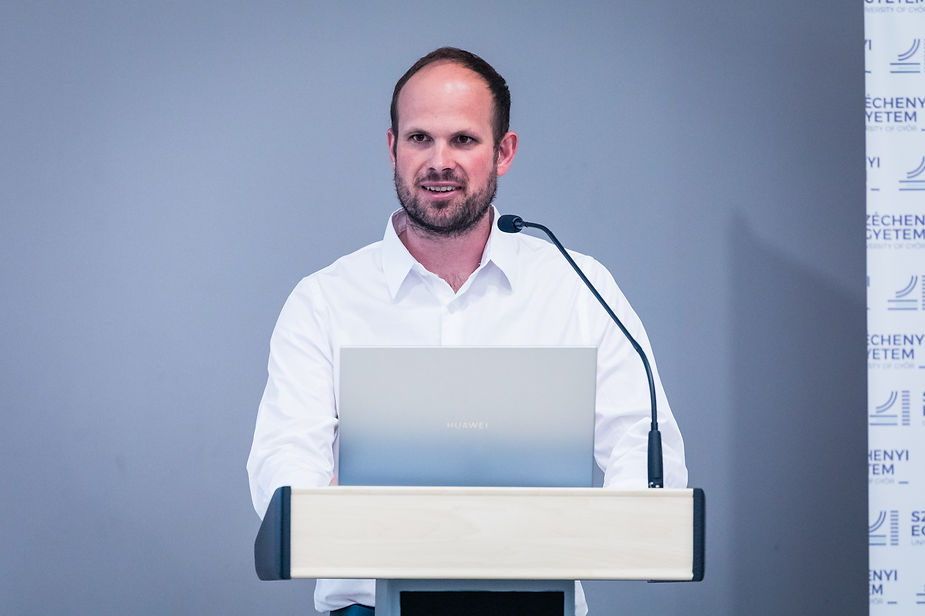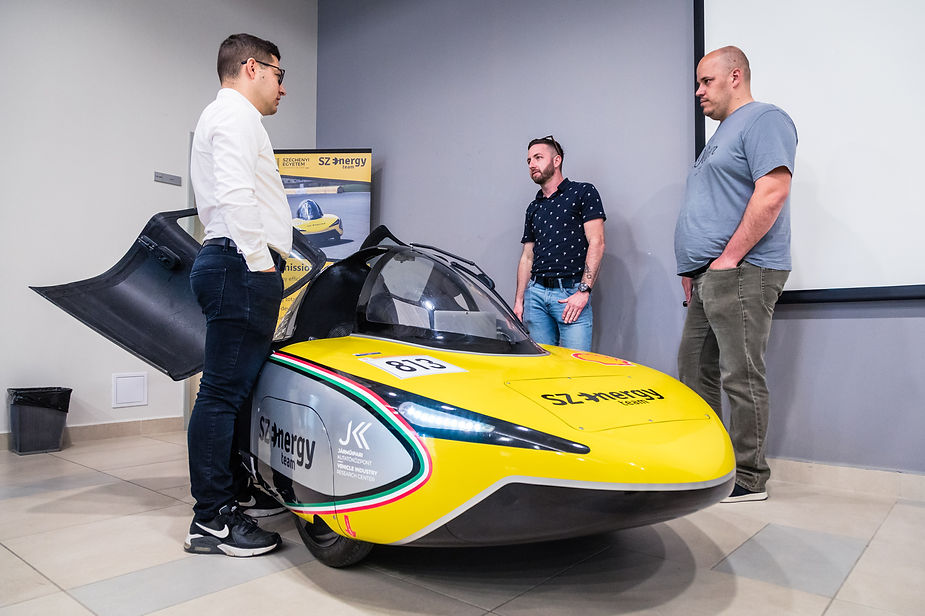SZEnergy presents its racing car: the team of Széchenyi István University is ready for the racing season
Source: SZE News – Márton Horváth
Last summer, the SZEnergy Team won Europe’s biggest energy-efficient car race with a world record, and this year it will compete in the Shell-Eco Marathon, where it is aiming to win the title in the traditional small city car category, and this year it is aiming for the top step of the podium in the self-driving car race, after finishing second last year. The team of students from Széchenyi István University presented their developments and unveiled this year’s car at the institution, and will soon travel to France to compete in the autonomous category on 19 May.
It is worth remembering:
Last year, the SZEnergy Team achieved the biggest success in its history, beating all its rivals – including the Universities of Munich, Toulouse and Milan – to win the Shell-Eco Marathon city car category with a near flawless performance.
This is an impressive achievement on a global scale: no one before them has been able to achieve an energy efficiency of 284 km/kWh. In essence, they covered the distance of two hours of ironing or 35 cups of tea on the race track near Assen, the Netherlands, using the team’s electric-powered vehicle, SZEmission. (The car did not actually cover 284 kilometres in the race, but only the proportional consumption calculated on the basis of the actual number of races completed.)
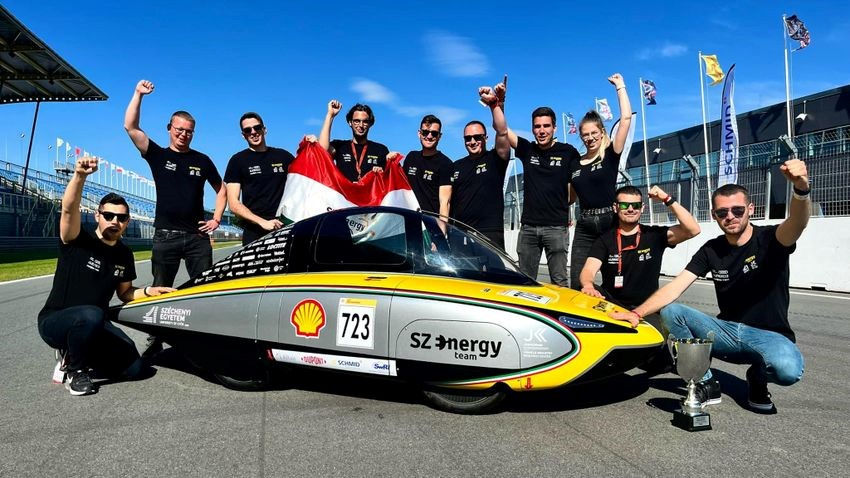
The team from Széchenyi István University has worked for many years to reach the top, competing in the urban concept car category since 2013, after the end of the solar class. The current vehicle competed for the first time in 2019, after years of fine-tuning to reach last year’s result. A lot of tweaking, optimising and testing – the fruits of a lot of work – came to fruition a year ago. Can this be improved? And in general: can last year’s excellent performance be repeated?
Last year’s world record makes the SZEnergy Team one of the best teams in the world. Of course, this also means that we are also competing against ourselves this year, and the biggest challenge is whether we can beat ourselves.
-emphasized in his speech Dr. Ferenc Szauter, head of the Széchenyi University Centre for Vehicle Industry Research Centre and former founding member, who added that the entire field will try to live up to the set reference, so a fierce fight is to be expected.
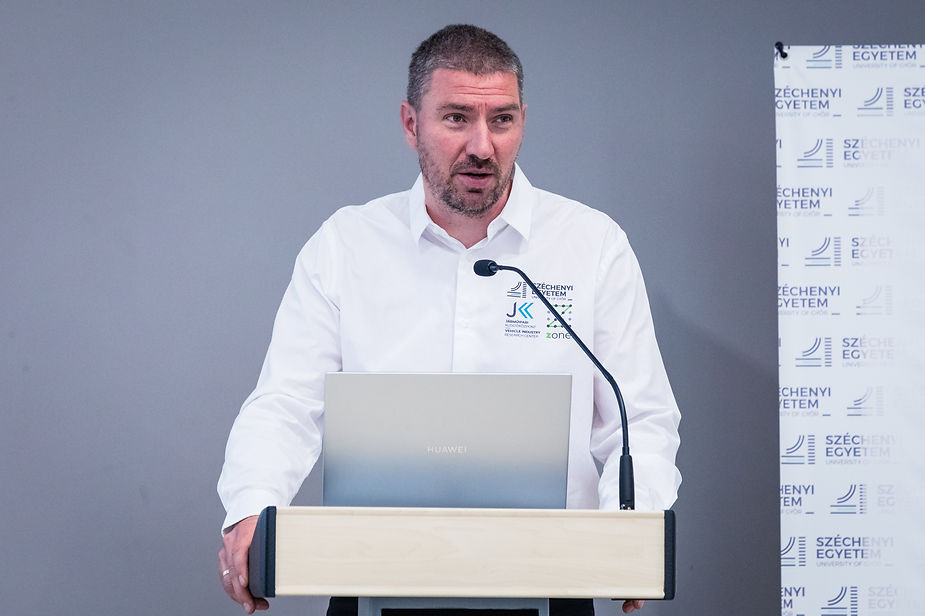
It can be seen from the above that
a repeat of last year’s performance may not be enough to win this year.
The team also knew it would be a mistake to simply dust off the world record car, and instead focused on further improvements from the start of preparations to remain competitive.
The fact that the champion car is unchanged is not an issue either, because the SZEnergy Team is a team of students, so its aim is not primarily to achieve results, but to educate young professionals: at Széchenyi István University, young engineering students gain practical experience similar to real projects in design, construction and racing, so it is important to fit something new to the car every year. This year was no different, and the rule changes required some changes.
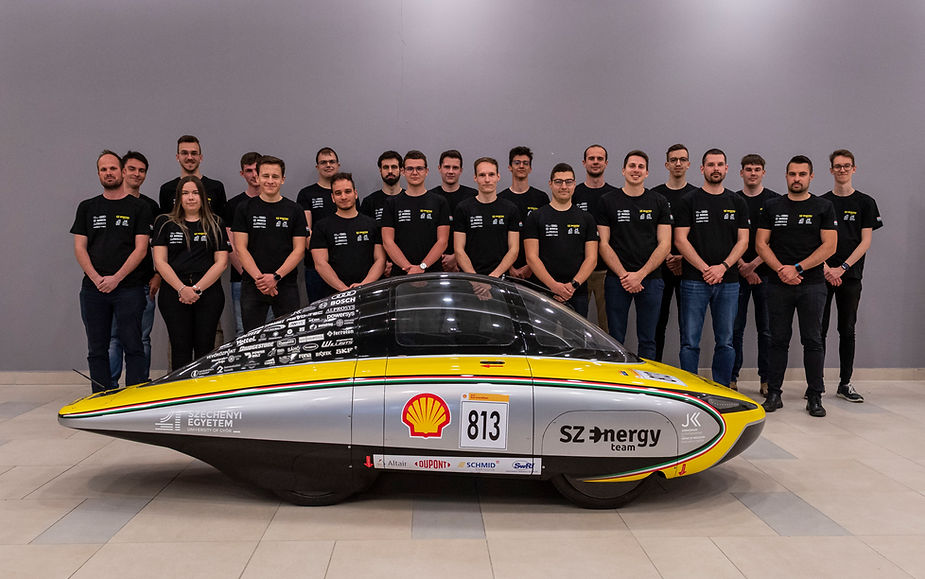
The team unveiled this year’s plans at the winter design freeze event and now, as the last stop before the races, they have unveiled this year’s vehicle and reported on the results so far. In the life of an engineering design competition team, this is called a rollout, a significant event as the build and testing phase is completed and then the live competition begins.
It is traditional for the team to make a closed presentation to sponsors, invited guests and members of the press on the development directions for the current year.
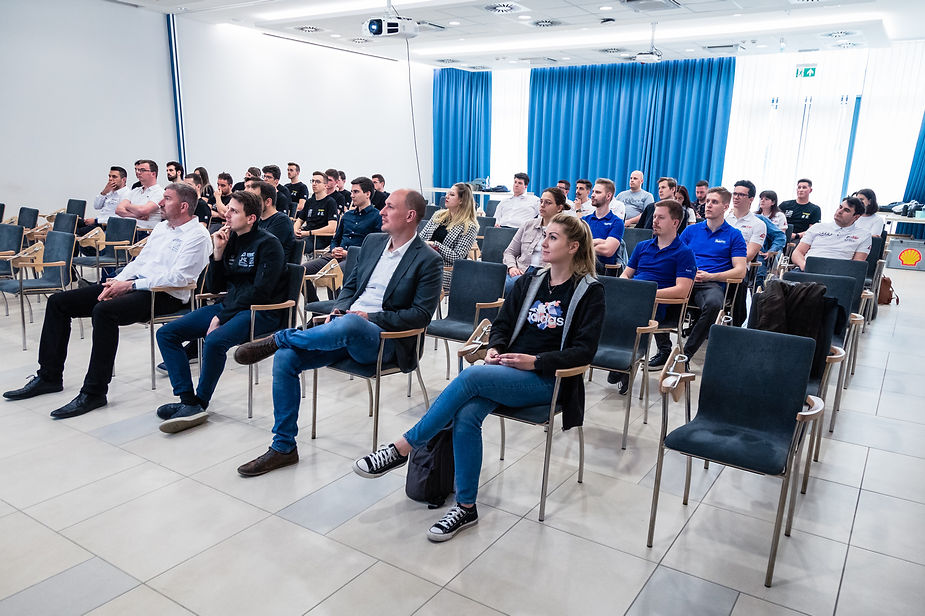
This year, we will be taking part in two competitions, which will be held consecutively, or even in parallel, in Nogaro, France. From 19 to 22 May, the team will be competing in the self-driving (autonomous) category, and from 20 May, the car will be on the track in the traditional energy-efficiency races. In practice, this means that we have to prepare both the car and the team for self-driving and driverless racing, which will not be easy logistically and technically, but we have done our best to meet the challenge.
– emphasized Dávid Krecz, team leader of SZEnergy Team.
The need to switch quickly between self-driving and traditional categories has led to the use of a modular powertrain, which means that the powertrain can be managed in a compact unit. It takes just five minutes for the team to change the drivetrain in the vehicle, which is fixed with a few screws.
Dávid Krecz explained,
the most important development in the engineering department this year is the clutch, familiar from conventional cars, which enables the ability to switch between free-wheel and fixed drive.
This year, the rule changes will require more stops, so a fixed drive with regenerative braking will also be needed. This will allow the car to feed the mechanical energy from braking back into the system. The installation of a clutch will allow the driver to switch between the two drives at will, which could make future races much easier.
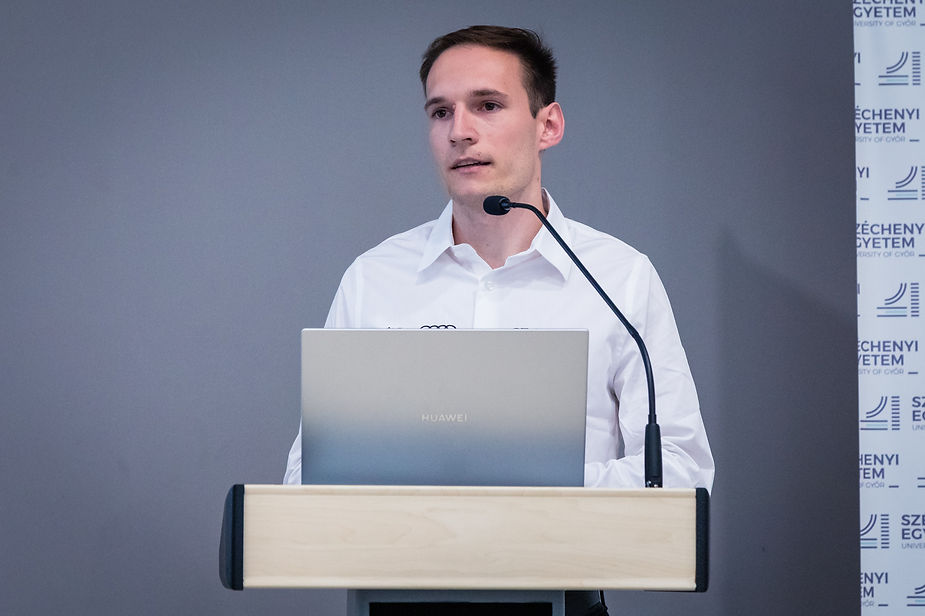
Another new feature is that
the team replaced the former commercially available spring strut with an elastomeric shock absorber of its own design.
As the coil spring component was designed for a much higher load, it was necessary to artificially increase the load on it by means of a transmission. The gearbox added weight, but with the new shock absorber, which was specially developed for the car, it can be omitted, which means a further weight reduction for the car. Since the car also has four of the devices, the saving is also multiplied by four.
As you can see from the above, the students found plenty of scope for modification and refinement in the car, which had previously been polished to perfection. However, there were also some modifications that were introduced based on the experience of previous years, such as the shading of the lidar sensor. This type of sensor scans the surrounding environment with a multitude of laser beams, so the sun’s rays can slightly reduce the accuracy of the measurement. However, this can be easily avoided by using a shade.
This year we also updated our tyres. The reason for this was that the previous tyre did not have enough tread ribs, so the judges did not consider it safe enough for rainy weather. The current tyres are not subject to such criticism. In order to ensure that the rules are observed, we have also replaced our wipers, used our own blades and modified the five-point safety belt.
–added the team leader.
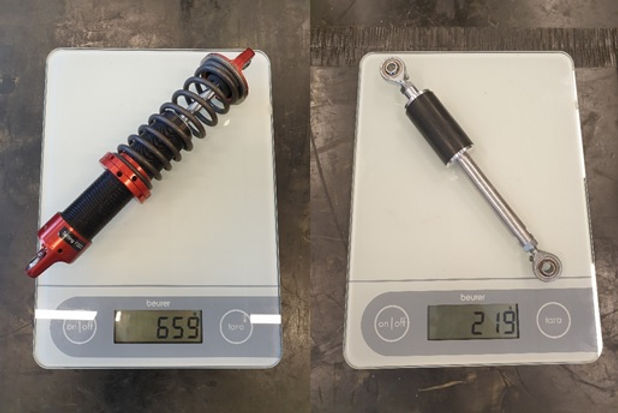
The developments of the electronics department were presented by István Kecskeméti, head of the department, who warned that although it is encouraging that
consumption has been brought below one watt, but this is something we will have to work hard for again this year. But the team’s plan is to cut another hundredth of a percent from the car’s energy consumption.
We have been working on driving cycle optimisation for years. This means that we can simulate track conditions and the car’s driving characteristics, so we can plan on the computer what the perfect lap on the track would look like. Based on this, we can always achieve the best energy balance. Although the simulation is not perfect, as we can never fully reproduce reality, the driving cycle calculated from it gives the driver a very good guide. The program tells you whether you need to accelerate or decelerate on a particular part of the track to achieve the best result. Previously, this interface ran on a dashboard-mounted tablet, but this year it has been replaced by a small LED display integrated into the steering wheel, which is not only more practical but also less power-consuming.
– István Kecskeméti explained the advantages of the new solution.
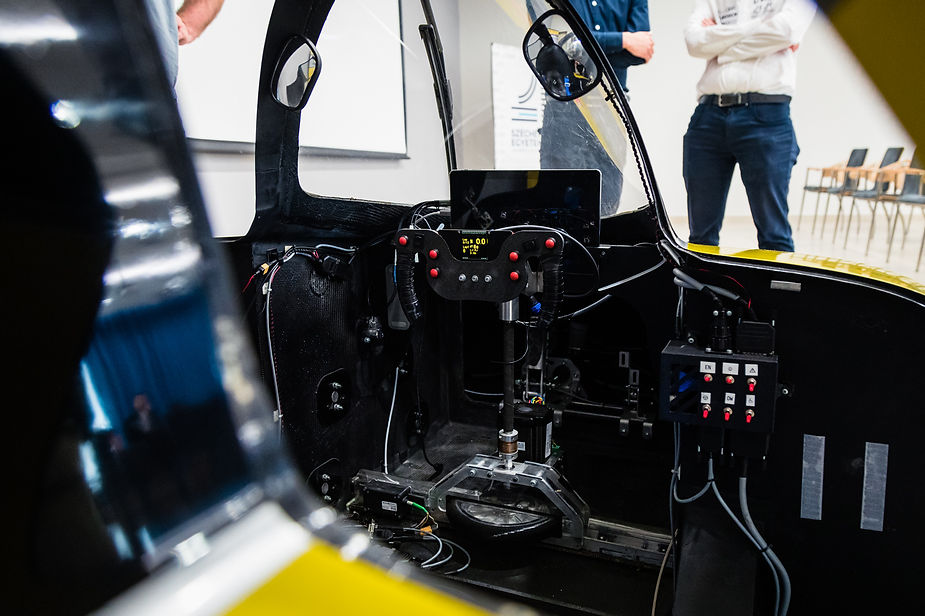
The electronics department also faced the challenge of rethinking the autonomous hardware platform. This unit is responsible for operating all the self-driving functions (including sensors), since all the relevant control and computing elements are on a single board. The advantage of this solution is that it can be easily removed from the car, so there is no need to worry about excess weight or power consumption in conventional racing. The sensors are only used when the vehicle is performing autonomous tasks, otherwise they are not needed.
Since in driverless mode the car uses a stereo camera to detect the free path, it is very important that we have doubled the computing capacity with a newer nVidia Jetson. More importantly, a dedicated device will be able to handle the video-based image processing, so we won’t have to share the capacity of our control unit, but will have standalone hardware working on it.
– István Kecskeméti justified the development.
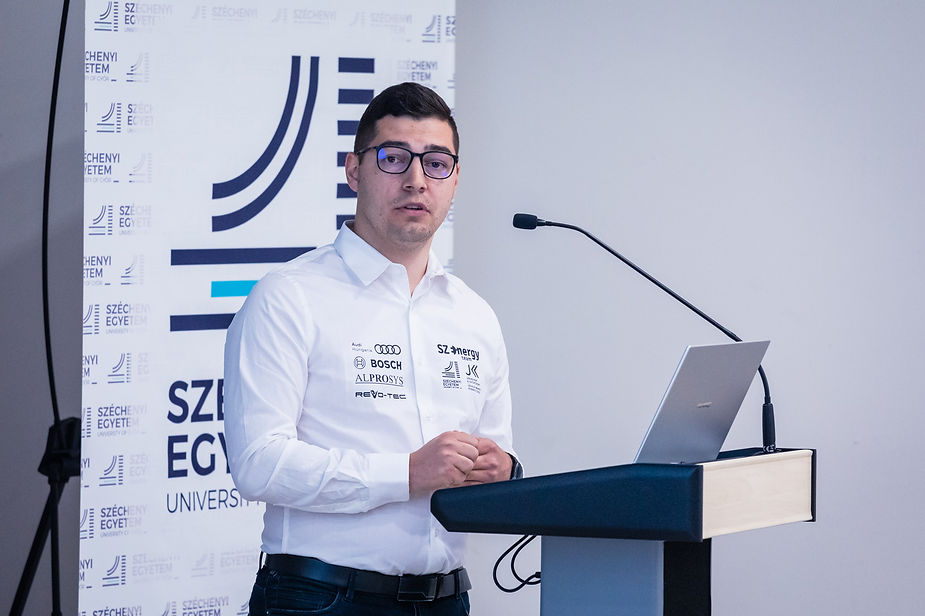
Miklós Unger, head of the autonomous department of SZEnergy Team, gave details about the self-driving functions. He reminded us,
last year the team finished a respectable 2nd place in the self-driving event. This year, the aim is to win again, but it will be difficult to achieve for two reasons: firstly, the field would have to be significantly wider and stronger than last year, and secondly, the organisers have changed the way the competition is run, from separate tasks (obstacle avoidance, parking, slaloming) to a single complex task with several parts.
Once the system is up and running, there is no possibility for the teams to intervene until the end of the track. This is a much more complex operation, which is a huge challenge for everyone and requires a lot of preparation.
The autonomous functions are solved in three levels, in three steps. We use a camera and a lidar sensor to sense the environment and use a neural network to determine where the free driving space is in the foreground of the car. In the route planning process, a trajectory, or path, is calculated, which is then fed to the car by a route-tracking algorithm, which transmits speed and steering angle parameters to the controller, which steers the car.
– briefly presented the background to the autonomous functions.
